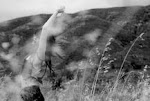

You can find this modern version of mates at 5800 Gorriti St. , Palermo
As some of you may know, mate is a traditional Argentinian drink. It was drank by the Indians in the Northern region of Argentina back in the 17th Century. The plant from which it's made, yerba mate, commonly grows there. The drink was later produced, consumed and sold massively by the missionaries. Slowly, mate made it's way into all of Argentina and to Buenos Aires in particular.
Mate is very popular because having it is considered a ceremony, and as in any ceremony, it has it's rituals. Having mate on your own or with friends, co-workers, relatives, etc., is a way to share good conversations and be in good company. Even if you are alone, you are in company of a "mate".
There are many types of mates nowadays but originally it was drank inside of a small pumpkin that was emptied and dried out. Yerba mate (or processed mate leaves) would go into the mate along with a straw and hot, not boiling, water (otherwise yerba mate gets burnt). As the bottom of the pumpkin was rounded, leather, silver, metal, and glass bases were created in order to allow for it to stand still. Historically, it's design has evolved many times, but not the way we drink it.
You need a mate set if you are interested in drinking mate. The set is made up of a container or mate, of course; a "bombilla" or metal straw (such as the one seen in the photos above) which has a strainer at it's end to keep yerba mate leaves from getting to your mouth; a "yerbera" that consists of two containers joined in the middle by a handle that is used to move it around. In one container you place, yerba, in the other, sugar; a kettle, with hot water.
If you are buying a traditional mate made out of pumpkin, ask in the store how you need to prepare it before having your first mate. There is a technique that assures your mate's taste will remain soft. No preparation is required if your mate is made out of metal, glass or any other material.
There are tricks to making good mate: fill up your mate with yerba, put it in hot water, wait for yerba to swell, insert the straw with out moving it sideways or in circles, and have the first drink or "fool's mate". It is called that way because first mate tastes very bitter and strong.
If you were the one who prepared the mate, then you are the person in charge of filling it up with water and sugar or honey (if you choose to add sugar or honey, although the custom varies from place to place) and, you're also the one that has to re- fill the mate's yerba when it's taste starts to fade. This makes you the "cebador". The mate ritual stops once you get tired of pouring mates for everyone, after mate has gone around a few rounds, and no one is supposed to take your place. If you are in the round and want to stop drinking, you can just say "thank you" and it will be interpreted as that. Otherwise, if mate is passed on to you, you take it and drink it and give it back to the person that is filling it who will do this and pass it on to person beside you.
Mate has its virtues. It stimulates circulatory, muscular systems a well as the central nervous system; it regulates digestion, works well as a diuretic and keeps you awake but, unlike coffee, mate does not accelerate your heart beat.
You can get yerba mate in any supermarket in Argentina as well as in some cities around the world such as London, NYC and Miami.
Enjoy your mate!




